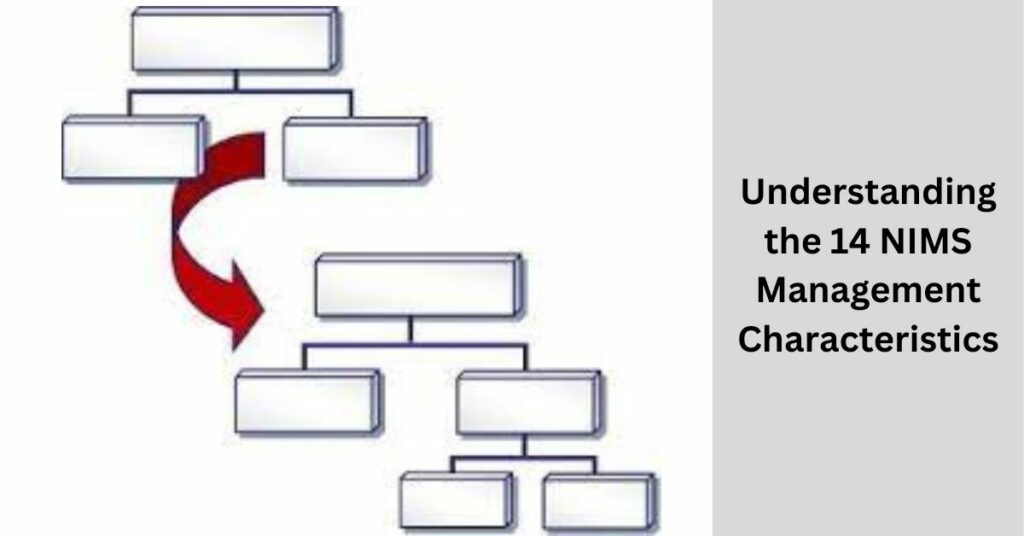Enhancing Emergency Response: Understanding the 14 NIMS Management Characteristics

In the realm of emergency management, effective coordination and organization are paramount for successful response efforts. The National Incident Management System (NIMS) serves as a comprehensive framework for managing incidents of all sizes and complexities.
Central to NIMS are its management characteristics, which provide a structured approach to handling emergencies. Among these characteristics, 14 key principles form the foundation of NIMS, guiding responders towards a unified and efficient response.
In this article, we delve into these 14 NIMS management characteristics, exploring their significance and impact on emergency management.
Table of Contents
Common Terminology:
Effective communication is fundamental during emergencies, where clarity and precision can make the difference between success and chaos. Common Terminology establishes a standardized language that all responders use, ensuring clear understanding and coordination across agencies and jurisdictions.
By employing consistent terminology for roles, resources, and procedures, Common Terminology minimizes confusion and enhances collaboration during critical incidents.
Modular Organization:
Modular Organization facilitates scalability and adaptability in response efforts by breaking down the management structure into manageable components.
Through the division of responsibilities into functional units, organizations can expand or contract their operations based on the evolving needs of the incident.
This modular approach fosters flexibility and efficiency, enabling responders to allocate resources effectively and maintain operational effectiveness across various incident sizes and complexities.
Management by Objectives:
Clear objectives are essential for guiding response activities and aligning efforts towards common goals. Management by Objectives emphasizes the establishment of specific, measurable, achievable, relevant, and time-bound (SMART) objectives for each operational period.
By defining clear objectives, incident managers can prioritize tasks, allocate resources efficiently, and evaluate progress effectively. This results in a focused and coordinated response, enhancing overall effectiveness and resource utilization.
Unified Command:
In complex incidents involving multiple agencies or jurisdictions, Unified Command ensures coordinated decision-making and action implementation.

Under Unified Command, representatives from involved organizations work together to develop a collective response strategy, share resources, and coordinate operational activities.
This collaborative approach fosters synergy, enhances situational awareness, and facilitates the resolution of interagency challenges, thereby improving overall response coordination and effectiveness.
Chain of Command and Unity of Command:
A clear Chain of Command establishes a hierarchical structure for decision-making and information flow within response organizations. Unity of Command ensures that each individual reports to only one designated supervisor, minimizing confusion and conflicting directives.
Together, these principles promote clarity, accountability, and efficient communication throughout the response hierarchy, enhancing operational effectiveness and maintaining organizational integrity.
Span of Control:
Span of Control delineates the optimal number of individuals a supervisor can effectively manage, balancing oversight and efficiency. By limiting the number of subordinates under each supervisor, Span of Control prevents overwhelming workload and facilitates clear communication and direction.
This principle ensures that supervisors can maintain situational awareness, make timely decisions, and provide adequate support to their teams, thereby optimizing operational performance.
Transfer of Command:
As incidents evolve or resources become depleted, the Transfer of Command ensures seamless transition and continuity of operations. By transferring command authority from one responsible party to another, incident management remains uninterrupted, and operational effectiveness is maintained.
This principle facilitates efficient resource utilization, enhances accountability, and promotes the sustainability of response efforts throughout the incident lifecycle.
Integrated Communications:
Effective communication is the lifeline of emergency response, enabling timely information exchange and decision-making. Integrated Communications establish interoperable systems and protocols that enable seamless communication among responding agencies and stakeholders.
By integrating various communication technologies and standardizing procedures, this principle enhances coordination, situational awareness, and operational efficiency, thereby improving overall response effectiveness.
Accountability:
Accountability is essential for ensuring transparency, responsibility, and integrity in emergency response operations. By establishing clear roles, responsibilities, and reporting mechanisms, Accountability promotes adherence to established protocols and procedures.

This principle enhances operational oversight, resource tracking, and performance evaluation, thereby fostering trust and confidence among responders and stakeholders.
Dispatch/Deployment:
Timely and efficient deployment of resources is critical for mitigating the impact of emergencies and saving lives. Dispatch/Deployment principles outline systematic procedures for resource allocation, mobilization, and tracking.
By optimizing resource utilization and response times, this principle enhances operational readiness and effectiveness, ensuring that the right resources are available at the right time and place to address emergent needs.
Information and Intelligence Management:
In the dynamic environment of emergency response, accurate and timely information is indispensable for informed decision-making. Information and Intelligence Management principles establish processes for collecting, analyzing, and disseminating relevant data and intelligence.
By enhancing situational awareness and supporting risk assessment, this principle enables responders to anticipate challenges, allocate resources strategically, and adapt their strategies accordingly, thereby improving overall response effectiveness.
Interoperability:
In multi-agency or multi-jurisdictional response scenarios, Interoperability ensures seamless integration and communication among disparate systems and organizations. By standardizing equipment, procedures, and protocols, Interoperability facilitates coordination, data sharing, and resource interoperability.
This principle enhances collaboration, enhances response capabilities, and maximizes the effectiveness of collective response efforts, regardless of organizational boundaries or technological differences.
Personnel Qualifications, Training, and Certification:
Effective emergency response requires competent and well-trained personnel capable of executing their roles and responsibilities proficiently. Personnel Qualifications, Training, and Certification principles establish standards and requirements for the recruitment, training, and certification of responders.
By ensuring that personnel possess the necessary skills, knowledge, and competencies, this principle enhances operational readiness, safety, and performance, thereby improving overall response effectiveness.
Resource Management:
Optimal resource management is essential for maximizing the efficiency and effectiveness of emergency response operations. Resource Management principles guide the identification, inventorying, mobilization, and tracking of resources throughout the incident lifecycle.
By prioritizing resource allocation based on incident needs, availability, and capability, this principle ensures that resources are utilized effectively, minimizing duplication and enhancing overall response capacity and resilience.
Incident Facilities and Locations:
Effective management of incident facilities and locations is crucial for establishing operational bases, coordinating resources, and facilitating communication during emergencies. This characteristic entails identifying suitable locations for incident command posts, staging areas, and support facilities based on factors such as proximity to the incident site, accessibility, and logistical considerations.
By strategically positioning facilities and resources, responders can optimize operational efficiency, streamline workflow, and ensure adequate support for personnel deployed in the field. Additionally, maintaining secure and well-equipped facilities enhances responder safety, comfort, and productivity, contributing to overall response effectiveness.
Public Information and Warning:
Public Information and Warning are essential components of emergency management, enabling authorities to disseminate timely and accurate information to the public and facilitate informed decision-making. This characteristic involves developing comprehensive communication strategies, protocols, and channels for delivering critical information, alerts, and instructions to affected communities.
By engaging with the public proactively and transparently, responders can mitigate confusion, reduce panic, and foster trust and cooperation among stakeholders. Moreover, effective public information and warning systems enhance community resilience, empower individuals to take appropriate actions, and facilitate the allocation of resources based on public needs and concerns.
Financial Management and Resource Support:
Financial Management and Resource Support are essential components of effective emergency response, ensuring the allocation and stewardship of financial resources to support response activities. This characteristic involves establishing mechanisms for budgeting, procurement, accounting, and reimbursement to manage costs associated with incident response.
By implementing sound financial management practices, organizations can optimize resource allocation, track expenditures, and maintain fiscal accountability throughout the incident lifecycle. Moreover, securing adequate funding and resource support enables responders to procure necessary equipment, supplies, and services, enhancing operational readiness and effectiveness.
Effective financial management also facilitates coordination with external partners, such as government agencies, NGOs, and private sector entities, to leverage additional resources and support for response efforts.
Conclusion:
The 14 NIMS management characteristics represent a comprehensive framework for enhancing emergency management capabilities and improving response effectiveness. By embracing these principles, organizations can foster collaboration, streamline operations, and mitigate the impact of emergencies on communities.
As the landscape of emergency management continues to evolve, understanding and implementing these management characteristics are essential for building resilient and adaptive response systems capable of addressing the challenges of tomorrow.


